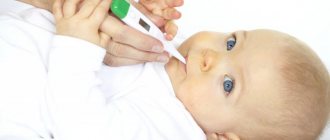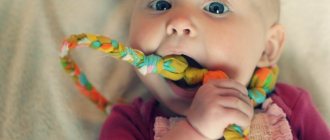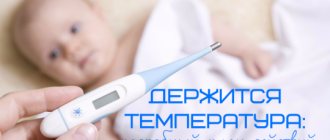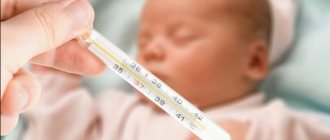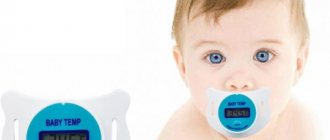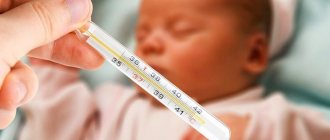Children under one year of age, due to the peculiarities of their physiology, may have a temperature exceeding the usual 36.6 °C. However, it can change throughout the day. Medical studies indicate what body temperature a child should have at 3 months. These indicators are equal to the normal values for children who are already six months old.
The baby's temperature is taken
Normal hyperthermia value for a 3 month old baby
It is impossible to answer with one value what temperature a child should have at 3 months. It can be argued that the permissible upper limit is 37.5˚C. If there are no additional symptoms, there is no need to talk about the child’s illness. An increase in body temperature within acceptable values, as a rule, occurs as a result of overheating. Parents often dress their children in too many clothes, wrap them in pajamas and cover them with duvets at night, trying to prevent the baby from becoming hypothermic. Overheating is much worse for a child than hypothermia.
The danger of overheating is due to underdeveloped sweat glands. During active play, dressed in several layers of clothing, the child certainly begins to warm up; the still imperfect sweating system does not give him the opportunity to sweat and cool down. As a result, the body overheats, the child feels unwell, and adults have cause for concern. Therefore, it is very important to keep the air in the room within normal limits: the thermometer and hygrometer readings must be within the specified values at t = 18-22˚C, humidity 55-65%, then the child’s normal body temperature will be ensured.
Indicators are normal
Attention! The normal temperature for a child differs significantly from the normal value for an elderly person. Therefore, if the older generation experiences discomfort when the air temperature in the room is 20 degrees, then this is not a reason to wrap up the child. Children feel comfortable in shorts and a T-shirt at this air temperature.
What to do if a child has a high temperature at 2 months?
As you know, not all systems of a newborn child function as well as those of an adult. This also applies to thermoregulation - up to three months of age, body temperature can greatly depend on the ambient temperature; its fluctuations do not necessarily mean illness, but at the same time, normal temperature does not guarantee the absence of infection. Therefore, if a child’s temperature rises at 2 months, first of all you should check whether he is wrapped up too warmly, whether the baby has been exposed to direct sunlight, or whether he has been in a room that is too hot for too long. Heat stroke is very dangerous for your baby, so it is best to ensure that he is always dressed for the weather.
The normal temperature for a two-month-old baby is from 36.2 to 37 degrees. If the baby screamed for a long time, the indicators may increase slightly, there is nothing wrong with that. The same applies to children who have just woken up.
If a two-month-old child's temperature rises above the normal level, that is, from 37.5 degrees, you need to immediately call an ambulance, especially when combined with other symptoms: lethargy or restlessness, increased breathing, heavy sweating, redness of the skin and inflamed, shiny eyes. Remember that the baby is still too young to wait for the high temperature to go away on its own!
You also need to call an ambulance if you know that an increase in temperature can cause convulsions in a child (that is, this has already happened), or if convulsions have already begun; when symptoms reminiscent of an allergy appear - runny nose, rash, watery eyes.
If the thermometer shows 38 degrees, then while the doctor gets to your home, you should try to reduce the fever. First of all, unwrap the baby, remove the blanket and make the room cool. At the same time, try not to create a draft, this is dangerous for the baby. It is best to completely undress the baby; if the child was wearing a diaper, be sure to remove it. At high temperatures, there is no need to wrap such a baby; on the contrary, the main task is to cool him down.
The baby can be wiped with a sponge or a clean cloth dipped in warm water. Cold water gives the opposite result and is not recommended. Under no circumstances should you use such “grandmother’s” methods as rubbing with vodka or vinegar. Thus, you can only worsen the situation by adding poisoning to the temperature.
A high temperature in a 2-month-old child may require medical intervention, but under no circumstances self-medicate - only a doctor can prescribe medications! As a last resort, consult with a therapist by phone while you wait for an ambulance.
Make sure you stay hydrated; dehydration can lead to additional health problems. Breast milk is best, of course. But in extreme cases, any other liquid that the child will drink is suitable - compote, children's tea, raisin decoction, brewed chamomile. In such a situation, you can even sweeten the liquid, the main thing is to prevent dehydration. It is best that the liquid is warm.
Useful video on the topic:
How to measure a small child's temperature
There are several types of different thermometers. Each of them reliably produces measurements, but has its own characteristics. Thus, the generally accepted 36.6˚C is the norm for the armpit. When measuring a child’s temperature using a pacifier thermometer, you need to keep in mind that the results obtained will be 0.6-1.2˚C higher than those that would be obtained when measuring in the armpit area. The same applies to devices equipped with an ear tip - it will also be 0.5-0.8˚C higher.
Various thermometers
Important! You should not measure the temperature of a child under 3 months of age in the auricle, since due to the characteristics of thermal processes in the body, the result may be unreliable. This method is more suitable for one-year-old children.
Using a traditional mercury thermometer, shake off the readings to below 35˚C before placing it in the armpit. The armpit should be dry, so if the child is sweating, the skin must be wiped clean of sweat. The duration of measurement in this way is 10 minutes. During the measurement, the child should be at rest and press the thermometer tightly with his hand to his body. To make the examination easier, the mother of a sleeping three-month-old baby can pick him up, insert the device into the fold between the arm and the torso and, pressing the device securely, hold the baby in her arms for 10 minutes.
Modern infrared thermometers allow you to measure indicators from the surface of the forehead without touching the head. Such devices are among the most expensive, but are considered the most accurate. The operating principle of such a thermometer is based on assessing the temperature of infrared radiation emanating from the surface of the body. The temperature of a 3 month old baby can be measured this way in a second.
IR thermometer
What to consider as a cause for concern
Seeing a doctor will not be a mistake for any increase in temperature, but there are cases in which consultation with a specialist is necessary under certain conditions for sure:
- If the body temperature does not decrease on the third day even by a small number of divisions.
- When on the fifth day the temperature did not return to normal or, on the contrary, increased.
- If parents are unable to give their child something to drink.
- When antipyretics do not bring relief.
The most important task of parents is to free the child’s body from food, especially heavy and fatty foods. The liver, overloaded with nutritional tasks, is unable to effectively fight the pathogen. Drinking plenty and often can save a child from the most dangerous result of fever - dehydration. It is precisely because of the danger of dehydration due to intestinal infections that children are placed in infectious diseases departments, where they use drips to help the body replenish fluid loss due to overheating and vomiting.
Signs of dehydration:
- there is no urge to urinate for a long time (dry diaper for more than three hours in a row);
- when the child cries, no tears appear;
- dry mouth;
- no effect, an hour after taking the antipyretic.
For any antipyretic drug to be effective, it needs to be absorbed into the blood. This will not happen if there is not enough fluid in the body. Drinking large amounts of compote, water, juice, fruit drink or herbal tea is the key to a successful and speedy recovery.
IV
When to use an antipyretic
An antipyretic is used regardless of the thermometer readings, when the child does not tolerate even the slightest increase in body temperature, which provokes a feverish state and convulsions. Also, an indication for the use of drugs is obvious hyperthermia - 39 degrees and above.
Attention! Under no circumstances should you rub the skin of a sick child with alcohol or vodka for antipyretic purposes. Sleep is absorbed into the blood through the skin, and the child can become alcohol intoxicated.
In other cases, an increase in the value from 37 to 38 degrees is left without drug treatment, allowing the body to independently produce interferon to fight the pathogen. This does not mean that nothing needs to be done; it is important to bring environmental indicators back to normal:
- the air in the room where a healthy child lives should not warm up more than +22 degrees Celsius, in a room with a sick child the temperature should be closer to +18;
- be sure to humidify the air in the room with an infant - comfortable hygrometer readings should be between 55% and 65%;
- The room should be ventilated several times a day;
- A sick child is not force-fed and is given plenty to drink.
Following these simple rules helps to keep the temperature of a 3-month-old child at normal levels more effectively than any antipyretic drug. The mentality of parents does not allow them to accept the fact that putting the room in order is not inaction, but the real and best help for a sick child with any disease.
Causes
A temperature of 39℃ in an infant under one year old and a cough can be caused by various diseases. An increase in fever directly indicates that a pathogenic agent has entered the body. The above symptoms do not exclude the development of such diseases.
Acute respiratory viral infection (ARVI)
The change of seasons often provokes interseasonal diseases, which are manifested primarily by increased temperature, which indicates acute respiratory viral infections or acute respiratory infections. Infants most often suffer from such diseases, because their immunity has not yet been formed and cannot cope with viruses and infections on its own. A baby with ARVI suffers from:
- elevated temperature up to 39℃;
- weaknesses;
- lethargy;
- nasal congestion;
- dry cough.
The baby may suffer from abnormal temperature conditions from 1 to several days. Basically, after 2-3 days, the thermometer returns to normal and does not rise above 37℃ until complete recovery.
Treatment and possible consequences
In any case, a slightly elevated temperature and the appearance of other signs of a respiratory infection are a good reason to take the baby to the pediatrician, since only properly selected therapy will help to quickly cope with the disease. At the same time, we should not forget that a sick child is a carrier of infection, which can spread to other children. And young children often suffer from complicated ARVI in the form of otitis media, pneumonia or an inflammatory process in the brain.
Bronchitis
A high temperature within 39℃ and a severe cough are clear signs of inflammation of the bronchi - bronchitis. The temperature may not decrease for about 4-5 days, after which it returns to normal. This pathological condition can be caused by:
- entry of a virus, bacteria or microbes into the bronchi;
- contact with an allergen;
- communication with a sick person;
- entry of toxins or harmful elements into the bronchi.
During progressive bronchitis, the following is observed:
- severe painful cough;
- temperature up to 39℃;
- lethargy and moodiness of the baby;
- body aches, which prevents him from sleeping fully and suppresses his appetite.
Treatment and possible consequences
The development of bronchitis in a baby’s body lasts at least three days. On the first day, acute signs of the disease are observed, which disappear by day 4-5, but may bother the child in the future.
The acute course of the disease can last 7 or more days, which requires taking urgent measures to prevent consequences in the form of bronchial asthma, emphysema, cardiopulmonary failure, and pulmonary hypertension.
Pneumonia
One of the most dangerous and serious diseases that affects the pulmonary system of infants is pneumonia. A pathological inflammatory process formed in the lung tissue can cause significant damage to the health and entire body of a small child. Pneumonia manifests itself as:
- wet cough;
- temperature rise to 39℃;
- lack of air and rapid breathing;
- wheezing.
A temperature within -39℃ is a clear sign of pneumonia, which can bother a child for a long time. At the same time, the cough is distinguished by the frequency of its manifestation, its persistence and the release of a characteristic rusty-colored sputum.
Treatment and possible consequences
Young children who develop symptoms of pneumonia should be seen by a specialist immediately. A timely examination by a doctor will help prescribe effective treatment and avoid complications such as insufficiency of the cardiovascular system, pleurisy, and disorders in the pulmonary structure.
Whooping cough
Very often, the appearance of a cough and a temperature of 39℃ in an infant indicates developing whooping cough. The nature of the disease is infectious. Children under 2 years of age are vulnerable to developing complications of the disease, which can be fatal for a young patient.
Symptoms of whooping cough similar in appearance to ARVI manifest themselves as:
- increased body temperature;
- runny nose;
- seizures;
- spasmodic cough;
- enlargement of the venous network in the neck;
- change in skin color.
Cough is a distinctive pathological sign of whooping cough, which has the character of an attack, variability in the form of minor declines and increases.
The baby may suffer from a cough for a week, in some cases longer. A coughing attack occurs against the background of suffocation and lack of oxygen. This condition is unacceptable for an infant, so you should call a doctor as soon as possible.
Treatment and possible consequences
If the immune system fails to cope and treatment is not prescribed in a timely manner, this becomes the cause of life-threatening and health-threatening consequences. We are talking about a bacterial complication in the form of pneumonia, otitis, pleurisy, encephalopathy, bronchitis.
Fever and cough are the first and most important symptoms that you should pay attention to and respond immediately. As a preventive measure, routine whooping cough vaccination should not be ignored.
Angina
The child develops a hoarse, guttural cough, more superficial, but not always. There is an unpleasant soreness in the throat. At the same time, a temperature raised to 39℃ is a clear sign of an inflammatory process to which the body reacts. The doctor will determine exactly where this process occurs and prescribe a method of treatment.
Treatment and possible consequences
Further treatment depends on the type of pathogen that caused the development of sore throat. It is important to isolate the patient and limit the baby from contact with others. Delay in treatment or incorrect diagnosis can lead to swelling of the larynx, accumulation of purulent masses on the tonsils, bleeding, which subsequently can lead to impaired functioning of the kidneys, liver, and sepsis.
Diphtheria
Diphtheria affects the tissues of the oropharynx as a result of the entry of the Loeffler bacterium there. The inflammatory process can spread and cover other tissues and organs: palate, tonsils, throat. Thus, the baby suffers from a sore throat, cannot swallow, and his body temperature is 2-3 degrees higher than normal.
Treatment and possible consequences
Loeffler's bacillus can spread throughout the body, thereby leading to a concentration of a toxic substance in the blood. The most dangerous consequence of diphtheria is the onset of biological death. Dangerous complications can be prevented by stopping the activity of the bacterium using an antitoxin.
Only a doctor can diagnose and treat diphtheria.
Pharyngitis
An inflammatory process in the pharynx can cause a dry, hoarse cough, which in acute pharyngitis is accompanied by a temperature of up to 39℃. In addition, if you feel your baby's lymph nodes, you can feel them enlarged.
Treatment and possible consequences
In no case should the symptoms of pharyngitis be ignored, since it is a consequence of the development of acute forms of scarlet fever, rubella or measles. In most cases, outpatient treatment will be prescribed with antibiotics, antihistamines, and gargling.
Tracheobronchitis
The disease can be caused by bacteria or viruses, but can be more accurately diagnosed through a clinical examination. Often, tracheobronchitis develops against the background of an existing disease and is secondary. It primarily manifests itself as a sore throat and fever.
Treatment and possible consequences
To prevent complications, you should promptly respond to the appearance of primary signs and show the baby to the doctor. Increasing immunity, proper treatment and following doctor’s recommendations will help avoid consequences in the form of focal pneumonia.
Other reasons
An abnormal temperature and cough do not always indicate the development of any disease.
| Overheating | Unpleasant symptoms occur in an infant when he is in a room that is too stuffy. The effect of increased temperature can be enhanced by parents trying to cover the baby with a blanket and warm him up by wearing warm overalls. Thus, the thermometer reading will increase, the cough will cause the baby to cry and worry |
| Teeth growth process | The eruption of the first incisors causes significant inconvenience to the baby. At the same time, a slight increase in temperature is considered normal; a cough and runny nose are possible. |
| Improper child care | A temperature of 39℃ and a cough are often caused by improper care of the nasal passages of the baby, who, due to his age, is not able to independently clean them of mucus and dust accumulated there. This irritates the mucous membrane, resulting in an inflammatory process. |
| Inflammation of the middle ear | In this case, the infection can affect the mucous membrane of the throat. This explains the debilitating cough and fever. Such undesirable symptoms do not always require treatment, since the signs may disappear within a few days on their own. But you should not neglect consultation with a doctor and it is better to take your baby to see a doctor. |
The need for drug treatment arises only in specific cases, since taking medications by an infant has a negative impact on the baby’s health. Medicines are a last resort if:
- temperature rise to 39℃ does not decrease over time;
- a deterioration in the child’s well-being is visible;
- the baby lacks appetite and sleep;
- sputum is not released from the body, which provokes a coughing attack.


